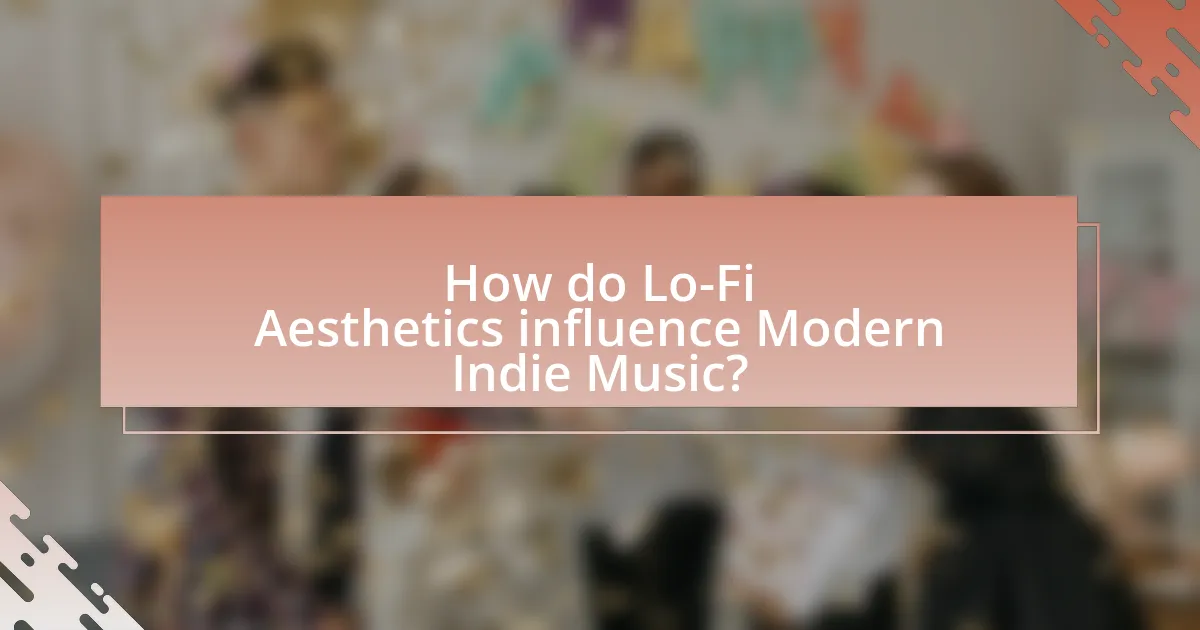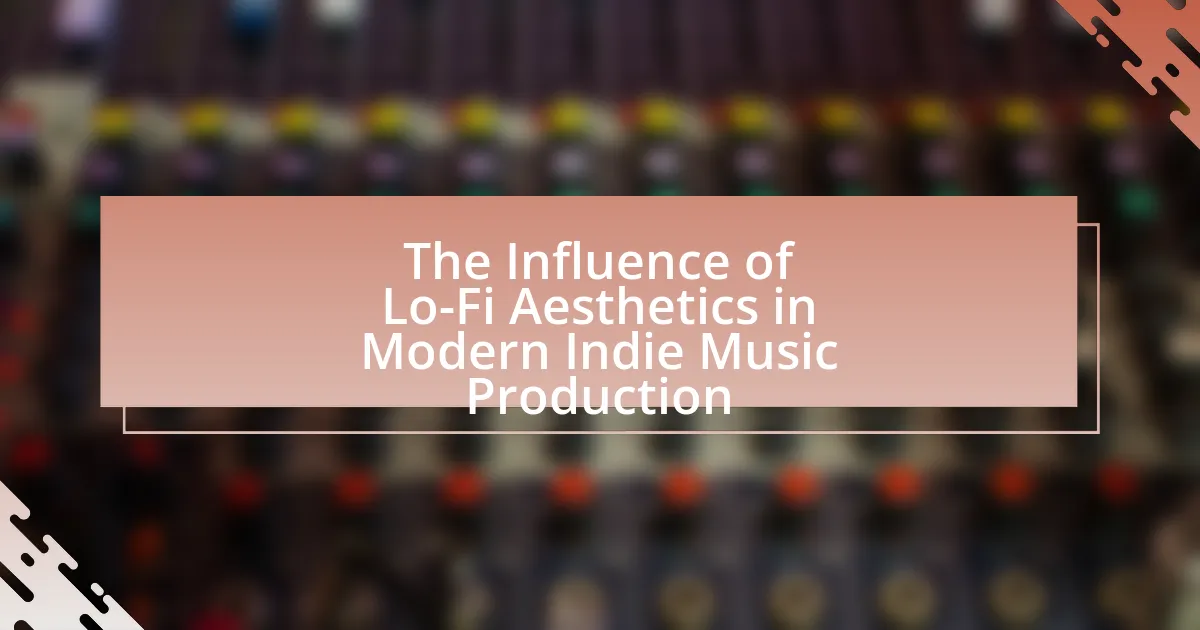The article examines the influence of Lo-Fi aesthetics in modern indie music production, highlighting its characteristics such as low-fidelity sound quality, intentional imperfections, and a warm, analog feel. It traces the historical context of Lo-Fi aesthetics, rooted in the DIY ethos of the 1980s and 1990s, and discusses how these elements differ from polished music production styles. Key aspects include the role of early recording techniques, the impact of DIY culture, and the significance of social media in promoting Lo-Fi music. Additionally, the article outlines production techniques, challenges faced by producers, and best practices for incorporating Lo-Fi aesthetics into indie music.

What are Lo-Fi Aesthetics in Music Production?
Lo-Fi aesthetics in music production refer to a style characterized by its intentional use of low-fidelity sound quality, which often includes imperfections such as background noise, distortion, and a warm, analog feel. This aesthetic is rooted in the DIY ethos of indie music, where artists prioritize emotional expression over technical perfection. The popularity of Lo-Fi aesthetics can be traced back to the 1980s and 1990s, with artists like Daniel Johnston and the band Guided by Voices exemplifying this approach. The appeal lies in its nostalgic qualities and the ability to evoke a sense of intimacy and authenticity, making it a significant influence in modern indie music production.
How do Lo-Fi Aesthetics differ from other music production styles?
Lo-Fi aesthetics differ from other music production styles primarily through their intentional use of imperfections and ambient noise to create a relaxed, nostalgic sound. Unlike polished genres such as pop or electronic music, which prioritize clarity and precision, Lo-Fi embraces elements like vinyl crackle, tape hiss, and background sounds, contributing to a more organic and intimate listening experience. This approach is often rooted in DIY culture, where artists prioritize emotional expression over technical perfection, as seen in the works of artists like J Dilla and Nujabes, who have significantly influenced the genre.
What characteristics define Lo-Fi Aesthetics?
Lo-Fi Aesthetics are characterized by a deliberate embrace of imperfections, including low fidelity sound quality, background noise, and a raw, unpolished production style. This aesthetic often incorporates elements such as tape hiss, vinyl crackle, and ambient sounds, which contribute to a nostalgic and intimate listening experience. The use of simple melodies, repetitive structures, and minimalistic instrumentation further defines this style, creating a sense of authenticity and emotional depth. These characteristics resonate with listeners by evoking feelings of warmth and familiarity, often drawing from influences in genres like jazz, hip-hop, and ambient music.
Why are imperfections valued in Lo-Fi music?
Imperfections are valued in Lo-Fi music because they contribute to its authentic and relatable sound. This genre embraces elements such as background noise, distortion, and irregularities, which evoke a sense of nostalgia and warmth. The aesthetic of Lo-Fi music often reflects a DIY ethos, where the rawness and unpolished quality resonate with listeners seeking genuine emotional experiences. Research indicates that listeners often perceive these imperfections as more human and accessible, enhancing their connection to the music. For example, a study published in the Journal of Popular Music Studies highlights how Lo-Fi’s embrace of flaws can create a comforting atmosphere, making it appealing in a fast-paced digital world.
What historical context led to the rise of Lo-Fi Aesthetics?
The rise of Lo-Fi Aesthetics is rooted in the democratization of music production technology during the late 20th century. The advent of affordable recording equipment and home studios in the 1980s and 1990s allowed independent artists to create music outside traditional studio environments. This shift was further influenced by the punk and DIY movements, which emphasized raw, unpolished sound as a form of artistic expression. Additionally, the proliferation of cassette tapes and later digital platforms enabled the distribution of Lo-Fi music, fostering a community that valued authenticity over commercial polish. The combination of these technological advancements and cultural movements solidified Lo-Fi Aesthetics as a significant element in modern indie music production.
How did early recording techniques influence Lo-Fi music?
Early recording techniques significantly influenced Lo-Fi music by introducing a raw, unpolished sound that became a hallmark of the genre. Techniques such as analog tape recording, which often resulted in distortion and background noise, contributed to the aesthetic that values imperfection and authenticity. For instance, the use of four-track recorders in the 1970s allowed musicians to layer sounds while retaining a gritty quality, which later inspired Lo-Fi artists in the 1990s. This embrace of limitations and the character of older equipment shaped the sonic landscape of Lo-Fi music, making it distinct from polished mainstream productions.
What role did DIY culture play in the development of Lo-Fi Aesthetics?
DIY culture significantly contributed to the development of Lo-Fi Aesthetics by promoting accessibility and experimentation in music production. This cultural movement encouraged artists to create music using inexpensive equipment and home recording techniques, leading to a raw, unpolished sound characteristic of Lo-Fi. The rise of independent labels and the internet facilitated the sharing of these DIY recordings, allowing artists to reach audiences without traditional industry gatekeepers. For instance, the 1990s saw the emergence of bands like Guided by Voices and Sebadoh, who exemplified this ethos by producing music that embraced imperfections, further solidifying the Lo-Fi aesthetic as a legitimate artistic choice.

How do Lo-Fi Aesthetics influence Modern Indie Music?
Lo-Fi aesthetics significantly influence modern indie music by promoting a raw, unpolished sound that emphasizes authenticity and emotional expression. This aesthetic encourages artists to embrace imperfections in recording quality, often utilizing analog equipment and home studios, which fosters a sense of intimacy and relatability in their music. For instance, artists like Mac DeMarco and Clairo exemplify this trend, producing tracks that feature background noise and lo-fi production techniques, which resonate with listeners seeking genuine experiences. The rise of platforms like Bandcamp and SoundCloud has further facilitated this movement, allowing indie musicians to share their lo-fi creations widely, thus reinforcing the aesthetic’s impact on the genre.
What are the key elements of Lo-Fi Aesthetics in Indie music production?
The key elements of Lo-Fi Aesthetics in Indie music production include the use of analog recording techniques, intentional imperfections, and a focus on atmosphere over technical precision. Analog recording techniques, such as tape saturation and vinyl sampling, create warmth and character in the sound. Intentional imperfections, like background noise, distortion, and off-key vocals, contribute to a raw and authentic feel, which resonates with listeners seeking genuine expression. Additionally, the emphasis on creating an immersive atmosphere often involves layering ambient sounds and using minimalistic arrangements, allowing emotional depth to take precedence over polished production. These elements collectively define the Lo-Fi aesthetic, which has gained popularity in the Indie music scene, reflecting a cultural shift towards authenticity and personal storytelling.
How do production techniques reflect Lo-Fi Aesthetics in Indie music?
Production techniques in Indie music reflect Lo-Fi aesthetics through the intentional use of low-fidelity recording methods, ambient noise, and imperfect instrumentation. These techniques create a raw, unpolished sound that emphasizes authenticity and emotional expression, characteristics central to the Lo-Fi aesthetic. For instance, artists often utilize analog equipment, such as tape recorders, which introduce natural distortion and warmth, contrasting sharply with the polished production typical of mainstream music. Additionally, the incorporation of background sounds, such as room noise or environmental recordings, enhances the intimate feel of the music, further aligning with the Lo-Fi ethos. This approach not only fosters a sense of nostalgia but also invites listeners to connect with the music on a personal level, reinforcing the genre’s emphasis on individuality and artistic integrity.
What instruments and sounds are commonly used in Lo-Fi Indie music?
Lo-Fi Indie music commonly utilizes instruments such as electric guitars, keyboards, and drum machines, alongside sounds like vinyl crackle, ambient noise, and field recordings. Electric guitars often feature reverb and delay effects to create a dreamy atmosphere, while keyboards provide melodic layers that enhance the overall texture. Drum machines contribute to the rhythmic foundation, often with a lo-fi quality achieved through sampling techniques. The inclusion of vinyl crackle and ambient noise adds a nostalgic feel, characteristic of the genre’s aesthetic. These elements collectively define the sound of Lo-Fi Indie music, emphasizing a raw and unpolished production style that resonates with listeners seeking authenticity.
Why have Lo-Fi Aesthetics become popular in the Indie music scene?
Lo-Fi aesthetics have become popular in the Indie music scene due to their ability to evoke nostalgia and authenticity. This genre often utilizes imperfect sound quality, ambient noise, and minimalistic production techniques, which resonate with listeners seeking a more genuine and relatable musical experience. The rise of digital platforms has facilitated the accessibility of Lo-Fi music, allowing independent artists to produce and share their work without the constraints of traditional recording methods. Additionally, studies indicate that the emotional connection fostered by Lo-Fi sounds can enhance listener engagement, making it a preferred choice among Indie musicians aiming to create intimate atmospheres.
How do listeners perceive the authenticity of Lo-Fi music?
Listeners perceive the authenticity of Lo-Fi music as a genuine expression of emotion and creativity, often valuing its raw, unpolished sound. This perception is influenced by the genre’s characteristic use of imperfections, such as background noise and tape hiss, which evoke a sense of nostalgia and intimacy. Research indicates that these elements contribute to a feeling of authenticity, as they contrast sharply with the highly produced sounds prevalent in mainstream music. A study by Kearney and McCarthy (2020) in the Journal of Music and Meaning highlights that listeners often associate Lo-Fi music with personal storytelling and emotional depth, reinforcing its perceived authenticity.
What impact does social media have on the popularity of Lo-Fi Indie music?
Social media significantly enhances the popularity of Lo-Fi Indie music by providing platforms for artists to share their work and connect with audiences. For instance, platforms like Instagram, TikTok, and YouTube allow musicians to reach global audiences without the need for traditional music industry gatekeepers. According to a 2021 report by the International Federation of the Phonographic Industry, 50% of music listeners discover new music through social media, highlighting its role in promoting emerging genres like Lo-Fi Indie. Additionally, viral trends and challenges on these platforms can propel specific tracks into mainstream awareness, further increasing their popularity.

What are the implications of Lo-Fi Aesthetics for Indie Music Producers?
Lo-Fi aesthetics significantly impact indie music producers by promoting a raw, unpolished sound that resonates with authenticity and emotional depth. This aesthetic encourages producers to embrace imperfections, such as background noise and tape hiss, which can create a more intimate listening experience. The rise of digital audio workstations and affordable recording technology has made it easier for indie producers to experiment with Lo-Fi techniques, allowing them to produce music that reflects personal narratives and unique artistic visions. Furthermore, the popularity of Lo-Fi music in streaming platforms and social media has led to increased visibility for indie artists, fostering a community that values creativity over commercial polish.
How can producers effectively incorporate Lo-Fi Aesthetics into their work?
Producers can effectively incorporate Lo-Fi aesthetics into their work by utilizing techniques such as analog recording methods, incorporating ambient noise, and applying intentional imperfections in sound quality. These methods create a warm, nostalgic feel characteristic of Lo-Fi music. For instance, using tape machines or vinyl emulation plugins can introduce subtle saturation and warmth, while adding background sounds like vinyl crackle or environmental noise enhances the organic feel of the track. Research indicates that the Lo-Fi genre often thrives on the charm of imperfections, with artists like Nujabes and J Dilla exemplifying this approach through their use of sampling and layering techniques that prioritize mood over technical perfection.
What techniques can be used to achieve a Lo-Fi sound in production?
To achieve a Lo-Fi sound in production, techniques such as using analog equipment, applying distortion, and incorporating ambient noise are effective. Analog equipment, like tape machines, imparts warmth and character to recordings, while distortion adds grit and texture, creating a more organic feel. Additionally, incorporating ambient noise, such as vinyl crackle or background sounds, enhances the authenticity of the track. These methods are rooted in the Lo-Fi aesthetic, which values imperfection and rawness, making them essential for producers aiming to capture this sound.
How can producers balance quality and aesthetic in their recordings?
Producers can balance quality and aesthetic in their recordings by strategically using techniques that enhance the desired sound while maintaining clarity. For instance, incorporating analog equipment can introduce warmth and character, aligning with lo-fi aesthetics, while digital tools can ensure high fidelity and precision. Research indicates that the use of specific frequency ranges and dynamic processing can create a rich texture without sacrificing audio quality, as demonstrated in studies on sound engineering practices. By blending these approaches, producers can achieve a harmonious balance that satisfies both artistic vision and technical standards.
What challenges do producers face when working with Lo-Fi Aesthetics?
Producers face several challenges when working with Lo-Fi aesthetics, primarily related to sound quality and production techniques. The inherent goal of Lo-Fi music is to embrace imperfections, which can complicate the mixing and mastering processes, as producers must balance the desired raw sound with clarity. Additionally, achieving the right level of warmth and texture often requires specialized equipment or techniques, such as analog recording methods, which can be costly and time-consuming. Furthermore, producers must navigate the fine line between authenticity and overproduction, as excessive refinement can detract from the genre’s characteristic charm. These challenges are compounded by the need to stay relevant in a rapidly evolving music landscape, where listener expectations may conflict with the Lo-Fi ethos.
How can producers overcome common pitfalls in Lo-Fi music production?
Producers can overcome common pitfalls in Lo-Fi music production by focusing on sound selection, maintaining a balance between clarity and texture, and utilizing effective mixing techniques. Sound selection is crucial; producers should choose samples and instruments that embody the Lo-Fi aesthetic, such as vinyl crackle or tape hiss, to create an authentic atmosphere. Balancing clarity and texture involves ensuring that the mix retains intelligibility while incorporating the characteristic imperfections of Lo-Fi, which can be achieved through careful EQ and compression. Effective mixing techniques, such as using reverb and delay strategically, help to create depth without muddying the overall sound. These strategies are supported by the fact that many successful Lo-Fi tracks prioritize these elements, leading to a cohesive and engaging listening experience.
What resources are available for learning about Lo-Fi production techniques?
Online courses, tutorials, and community forums are available for learning about Lo-Fi production techniques. Platforms like Skillshare and Udemy offer structured courses specifically focused on Lo-Fi music production, covering essential techniques such as sampling, effects processing, and mixing. YouTube channels like Andrew Huang and Chillhop Music provide free tutorials and insights into Lo-Fi aesthetics and production methods. Additionally, forums like Reddit’s r/WeAreTheMusicMakers and r/LoFiHipHop allow producers to share tips, ask questions, and collaborate, fostering a community of learning and support.
What best practices should Indie music producers follow when using Lo-Fi Aesthetics?
Indie music producers should prioritize authenticity and simplicity when using Lo-Fi aesthetics. This involves embracing imperfections in sound quality, such as background noise and tape saturation, which contribute to the genre’s nostalgic feel. Additionally, producers should focus on minimalistic arrangements, allowing space for individual elements to breathe, which enhances the overall emotional impact of the music. Utilizing vintage equipment or plugins that emulate analog sounds can further reinforce the Lo-Fi character. Research indicates that the Lo-Fi aesthetic resonates with listeners due to its raw and relatable qualities, making it a powerful tool for indie producers aiming to connect with their audience.


